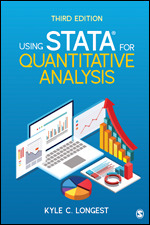Using Stata for Quantitative Analysis
- Kyle C. Longest - Furman University, Greenville, SC, USA
Quantitative/Statistical Research (General) | Research Methods & Evaluation (General) | Statistics
Using Stata for Quantitative Analysis offers a brief but thorough introduction to analyzing data in undergraduate and graduate level research methods, statistics, and data analysis courses using Stata software. Kyle C. Longest teaches the language of Stata from an intuitive perspective, allowing students with no experience in statistical software to start working with data quickly and complete a basic quantitative research project from start to finish.
The Third Edition covers the use of Stata 15 and includes more information on data management and non-linear regression techniques. Enhanced layouts make finding important commands easy.
Supplements
“Learning to use statistical software can be an intimidating experience that is often made excessively difficult by textbooks that provide unclear explanations and overwhelming detail. In Using Stata for Quantitative Analysis, Longest well balances overview and detail of Stata’s components, commands, and instructional resources that will help new users.”
A wonderful overall resource. However, its coverage of non-parametric methods is very slim. Yet these methods are critically needed in the health sciences where non-normally distributed data dominate our analysis.

